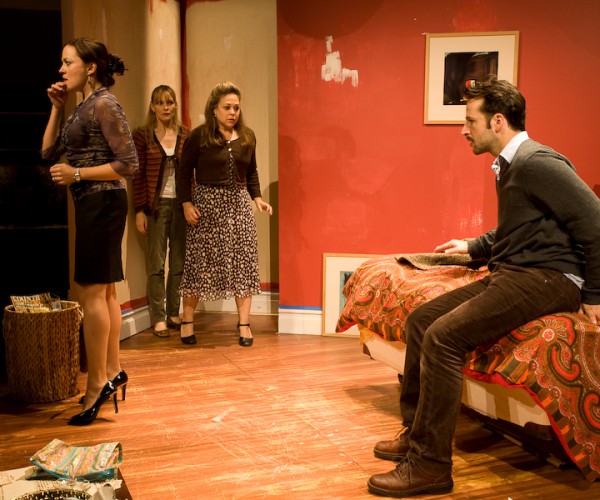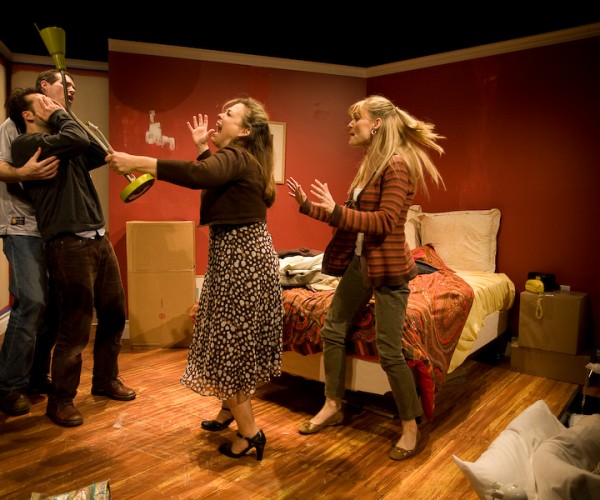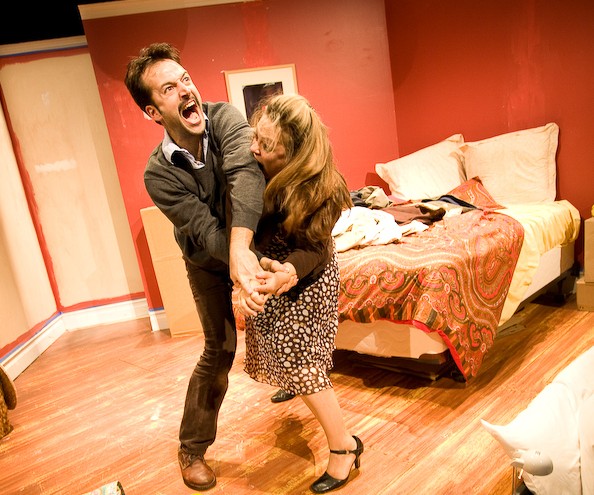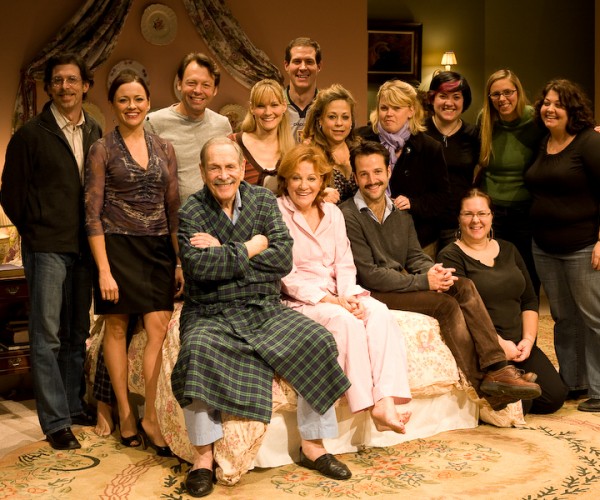Dramaturgy
Alan Ayckbourn is a one-man theater machine. Since 1959, he has written seventy-two plays, forty-one of which have been produced in the West End. Not merely a playwright, Ayckbourn is also a prolific director, both of his own plays and others. Since 1972, Aykbourn has been the artistic director of the Library Theatre in Scarborough (now relocated to the Stephen Joseph Theatre), his home and the venue where all of his major plays premiered, including Bedroom Farce. In 1974, Ayckbourn had five plays running simultaneously in the West End, a world record broken only by Andrew Lloyd Weber. For a man some have claimed is the most produced living playwright in the world, is there room for one more production?
Despite his huge popularity in England, Ayckbourn never achieved the same level of fame and success in America. Bedroom Farce, a massive commercial hit in London, played on Broadway for seven months in 1979, garnering Tony nominations for best play and best director (shared between Ayckbourn and Peter Hall). In the tough economic climate of the Broadway play, however, Ayckbourn was hardly a knock-out success, even with a decent critical reception and positive reviews. The play has since been revived by Ayckbourn himself in Scarborough and in 2002 with a disastrous high-profile production in the West End starring Richard Briers. Repertory and amateur productions of Bedroom Farce do occur, both in England and in the United States, but while the play might not be neglected in terms of quantity of productions, it certainly has been in the realm of serious study and respectability. There are shockingly few scholarly articles about Alan Ayckbourn at all. This problem has plagued Ayckbourn throughout his career, labeled early on as a British Neil Simon, seen as immensely talented and capable of writing uproariously funny fluff, but not a thinking man’s writer. Luckily, this reputation has begun to shift.
Ayckbourn has always had his supporters, not least among them Peter Hall, the prominent English director and former artistic director of the Royal Shakespeare Company. In the mid 1970’s, Hall took over from Laurence Olivier as the head of the new National Theatre. In 1848, philanthropist Effingham Wilson first proposed building a subsidized theater to showcase the best talents of England in a venue everyone could afford to attend. After World War I, the British Arts Council was formed, which began subsidizing a number of theaters, reducing the immediate importance of establishing an “official” national theater. In 1949 parliament voted to spend a million pounds for building the new theater, but delays on construction and various bureaucratic difficulties halted the project, forcing the National Theatre to operate out of the already existing Old Vic under the leadership of Laurence Olivier. When Peter Hall took over, he made it a priority to finally construct the new building, a massive complex housing three individual theaters of varying sizes and layouts on a tight budget and under intense scrutiny. Hall was appointed a daunting task, not only in physically assembling the theater but also in developing a distinct and clear identity for it.
Hall’s conviction in Alan Ayckbourn’s talent and importance was a turning point both for Ayckbourn and the National Theatre. Already known for his West End comedies, Ayckbourn had developed a working relationship with commercial London producer Michael Codron. Therefore, it was a surprising move when Peter Hall commissioned Bedroom Farce from Ayckbourn specifically for the government subsidized National. Hall endured a fair amount of criticism in certain circles for this decision, a move many decried as a sell-out for commercial success by a National Theatre that should only use its limited resources to produce work of artistic merit that would be un-producible in the West End. The assumption that commercial work is artless and artful work cannot be popular was one Hall and Ayckbourn fervently denied.
The commission in hand, Hall left Ayckbourn to write and test the play himself in Scarborough. In typical Ayckbourn fashion, the play was written mere days before the first full reading, despite the fact that the title “Bedroom Farce” had been planned for months to ease the printing of flyers and posters. The end result was a play seemingly light and entertaining, but with an honest portrayal of the ups and downs of relationships at its core, a darker streak common in Ayckbourn’s work. Hall, placing great confidence in Ayckbourn, staged and blocked the London production in a week. He then turned the show over to Ayckbourn for the remaining seven weeks of rehearsal. While the final play has a shared director credit for both Hall and Ayckbourn, Peter Hall wisely stayed out of Ayckbourn’s way, purposefully scheduling conflicting rehearsals for another show he was directing one theater over. The ploy was a great success since it gave Ayckbourn his first opportunity to direct the London production of one of his plays while easing the confidence of those concerned with Ayckbourn’s inexperience (in reality, a baseless concern since Ayckbourn had been directing the pre-London world premieres of his plays in Scarborough since the late 60’s).
When the play finally opened in London on March 16, 1977, it was a great success both critically and with popular audiences. Demand was so high that the production was extended to a commercial run in the West End, a financial success that helped bolster the National in its early years of financial uncertainty. In addition to the Broadway run, the play was also filmed for television. Reaching the height of popularity, there was even a bizarre proposal that now seems gloriously misguided and thoroughly American. Two of the characters in the play, Ernest and Deliah, were developed for a half-hour sitcom, a project that was eventually squashed by Ayckbourn.
Yet the play’s enormous commercial and popular appeal only tell half the story. Personally, for Ayckbourn, Bedroom Farce represents a major turning point, a shift between his earlier role as the pleasing comedian and the later, more mature playwright. Splitting the stage into three separate bedrooms, he continued an experiment with theatrical space that has recurred throughout his career. In The Norman Conquests (1973), he had written a trilogy of three plays taking place in the same span of time over different rooms in one house. Further experiments, such as the overlapping of two separate locations in one stage space in How the Other Half Lives (1969) or the coin-toss determined alternate endings of Sisterly Feelings (1979) showed that Ayckbourn had a unique flair for theatrical invention and imagination. In Bedroom Farce, he was able to integrate these formalistic techniques with an accessible and entertaining story. As the itinerant couple, Trevor and Susannah, move through the bedrooms of the other three, they separate, come together, drift apart, and come together again while lights rise and fade from one room to the next. Michael Billington, theater critic for the Guardian and Ayckbourn’s biographer, describes it as, “one of those rare plays in which form and content achieve a blissfully happy marriage.”
Not a farce in the traditional sense of the word, the characters form the heart of the play. Ayckbourn himself explains it best: “Comedy, I read somewhere, consists of larger than life characters in real situations. Farce, on the other hand, portrays real characters projected into incredible situations. Bedroom Farce is a comedy about real characters who, projected into incredible situations, start behaving in a larger than life manner as the situations appear to them too horribly real.” Balancing a thin line between devastating reality and flimsy comedy, Ayckbourn’s play manages to convey something about both worlds. As a result, the play never veers too far into the absurd territory of the fast-paced sex farce. In an interview, Ayckbourn explained his reasoning: “It’ll have everything about bedrooms except copulation, something which I believe is hardly practiced in the British bedroom anyway.” So Ayckbourn’s characters eat, complain, argue, use the telephone, and assemble furniture, but sex is hardly mentioned. Refusing to lower his characters to mere hysterical maniacs, Ayckbourn infuses them with reality – boredom, physical pain, discomfort, and uncertainty. They unfold naturally or, in Ayckbourn’s words, “they retain the dignity of resolving their own destinies.”
The destiny of Alan Ayckbourn is not yet resolved. At 69 years old, he continues to write and direct at least one play a year, even after a stroke in 2006. He has announced that he will leave behind his position as artistic director of the Stephen Joseph Theatre in 2009, but with no sign of slowing down on the writing and directing front. As his work has matured, he has branched into bleaker and more “serious” subject matter, but he has never abandoned comedy. For Ayckbourn, comedy is not a dirty word, and there is no absolute dividing line between intellectually stimulating “drama” and crowd-drawing “popular plays”. Ayckbourn has joked that he purposefully writes plays that will not be put into curriculums to be dreaded by schoolchildren the world over, but when Oscar Wilde and Ben Jonson have entered the literary canon, there is no reason to think Ayckbourn will not be accorded the same importance in years to come.




